We’ve all been there – happily sewing away on a project, only to be frustrated by those pesky skipped stitches. It’s like your sewing machine has a mind of its own, deciding to skip stitches just to throw you off your groove.
But fear not!
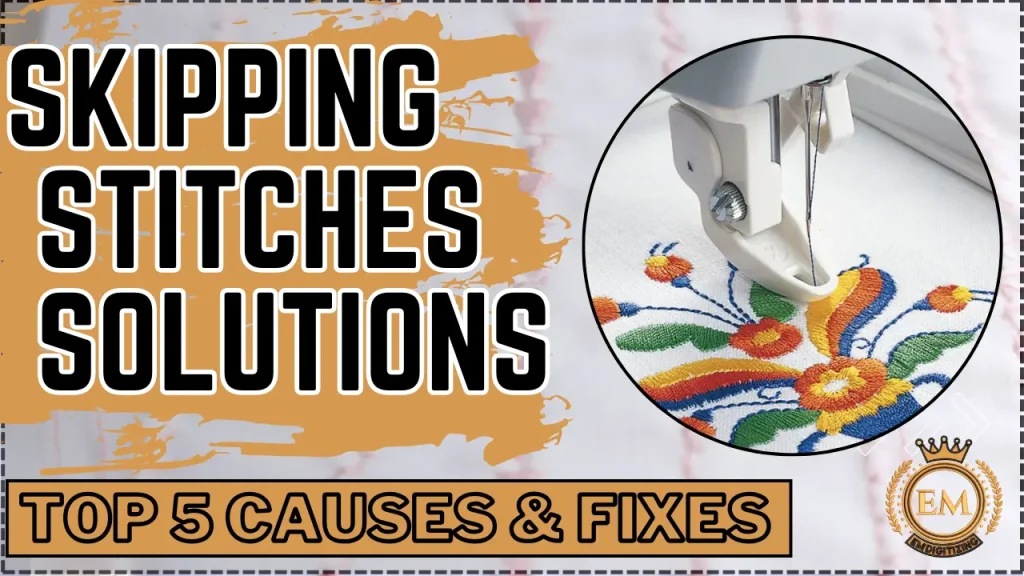
In this article, we’ll explore the top five causes with skipping stitches solutions to get your stitches back on track.
So, grab your sewing machine, and let’s dive in!
10 Compelling Reasons Why You Need Custom Embroidery Digitizing
Cause 1: Incorrect Needle Size
The first problem with skipping stitches solutions is using an incorrect needle size in embroidery or sewing, which can lead to a host of problems, affecting both the machine’s performance and the stitch quality of the finished project.
Importance of Using the Correct Needle Size
Believe it or not, using the right needle size can make all the difference in your sewing experience. Imagine trying to sew a chunky knit fabric with a tiny needle – it’s like trying to knit a sweater with toothpicks.
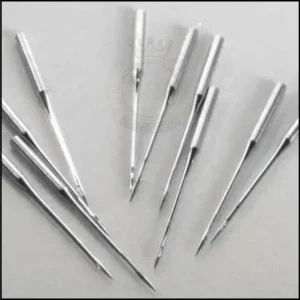
Using the correct needle size ensures that the needle can smoothly penetrate the fabric and create even stitches.
Signs of Using the Wrong Needle Size
If you’re experiencing with this stitch type, it might be an indication that you’re using the wrong needle size. Pay attention to how the needle interacts with the fabric.
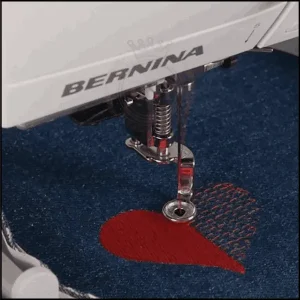
Are you seeing skipped or uneven stitches? Is the fabric puckering or stretching?
These can all be signs that your needle size needs a tweak.
Selecting the Right Needle Size
Selecting the right needle size doesn’t have to be a guessing game. Check the fabric’s weight and match it to the appropriate needle size.
Thicker fabrics like denim or canvas may require larger needles, while delicate fabrics like silk or chiffon may need smaller needles.
Remember, a well-matched needle size is the key to straight and skip-free stitches.
Cause 2: Tension Issues
Tension issues in sewing and embroidery can significantly impact the quality of your stitches, leading to uneven, puckered, or loose stitches that detract from the final product.
Understanding Sewing Machine Tension
Ah, tension – the mysterious force that can make or break your stitches. Sewing machine tension refers to the balance between the top thread and the bobbin thread.
When the tension is too tight or too loose, it can result in skipped stitches or even thread breakage. Understanding and adjusting your tension can save you from this stitching nightmare.
Identifying Tension Problems
So, how can you tell if your tension is off? For skipping stitches solutions to this problem is to take a look at your stitches. Are the top stitches pulling through to the bottom or vice versa?

Do you notice loops or puckering? These are signs that your tension might need some fine-tuning.
Adjusting Tension for Smooth Stitches
Fear not, brave sewist!
Adjusting your machine’s tension is easier than it sounds. Start by referring to your sewing machine’s manual for specific instructions on how to adjust tension.

Typically, you can make small adjustments using the tension dial. Gradually tighten or loosen the tension until you achieve even stitches that don’t skip. And remember, a little trial and error might be required to find that sweet spot.
Cause 3: Thread Problems
Thread problems in sewing and embroidery, such as breakage, tangling, and shredding, can be frustrating hurdles that disrupt the flow of your projects and affect stitch quality.
Using High-Quality Thread
When it comes to threads, quality matters. Using low-quality or old thread can lead to skipped stitches and frustration. Invest in high-quality thread that won’t fray or break easily.
Trust us, your stitches will thank you.
Checking for Thread Tangles or Knots
Before diving into a sewing project, take a moment to examine your thread. Is it tangled or knotted?
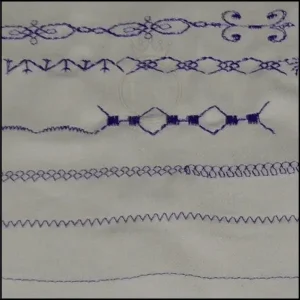
These thread obstacles can cause your stitches to skip. To avoid this, unwind the thread and check for any tangles or knots.
Smooth sailing stitches await!
Proper Thread Placement and Tension
There is a skipping stitches solutions to this problem!
Thread placement and tension play a vital role in stitch formation. Ensure that your thread is properly seated in the machine’s tension discs and that the thread flows smoothly through the thread guides.
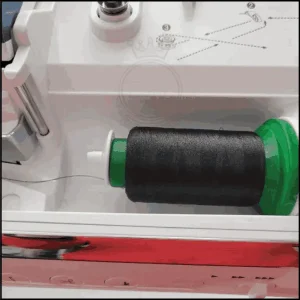
Also, check that the bobbin thread is wound correctly and placed in the bobbin case with the correct tension. When everything is in its rightful place, skipped stitches will become a distant memory.
Cause 4: Sewing Machine Maintenance
When it comes to sewing machine issues, neglecting maintenance can often be the culprit behind skipping stitches.
Just like any other mechanical device, sewing machines require regular cleaning and lubrication to keep them running smoothly.
Regular Cleaning and Lubrication
Now, let’s have a look at the skipping stitches solutions to this problem!
Cleaning your sewing machine regularly is essential to remove any lint, dust, or stray threads that may be causing hiccups in your stitching. It’s like giving your machine a spa day – pampering it and ensuring it’s in its best working condition.
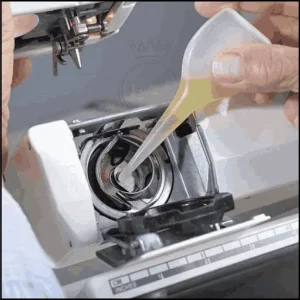
Don’t forget to also lubricate the necessary parts as recommended by your machine’s manual, as this helps reduce friction and keeps everything running smoothly.
Checking and Replacing Worn Parts
Just like a tired marathon runner, worn-out parts can affect the performance of your sewing machine. Keep an eye on critical components such as needles, feed dogs, and presser feet.

If any of these parts look worn or damaged, it’s time to give them a proper retirement and bring in some fresh replacements. Trust me, your machine will thank you.
Correct Bobbin Placement and Alignment
Ah, the ever-elusive bobbin. If your stitches are skipping, double-check that the bobbin is correctly placed and aligned.
A bobbin that’s not seated properly or aligned with the thread tension mechanism can cause all sorts of stitch-related chaos.
So, take a quick peek, make the necessary adjustments, and get back to the smooth stitching you deserve.
Cause 5: Operator Error
Sometimes, the blame for skipped stitches falls squarely on our shoulders. Yes, we’re referring to operator error.
Don’t worry; it’s not the end of the world. We’ve all been there, making our fair share of sewing blunders.
Let’s dissect some common mistakes and check out skipping stitches solutions to this problem.
Improper Handling of the Fabric and Machine
No, your fabric isn’t plotting against you, but it can certainly impact your stitching. Pulling the fabric too forcefully or not providing enough support can lead to uneven tension and ultimately result in skipped stitches.
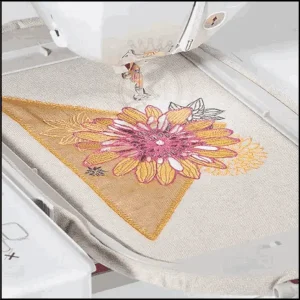
Treat your fabric with kindness and ensure it’s properly guided through the machine, so it cooperates with your stitching ambitions.
Inadequate Stitching Technique
Stitching technique matters, my friend. You may need to adjust your stitch length or tension to match the fabric you’re working with.
Experiment and find that sweet spot where the stitches glide smoothly through the fabric, leaving no room for skipping.
Remember, practice makes perfect, or at least gets you closer to it.
Overworking the Machine
Easy there, Speed Racer! Sewing machines have their limits, just like we humans do.
Overworking your machine by sewing too fast or using it continuously for extended periods can cause it to get overheated and throw a little temper tantrum in the form of skipped stitches.
Take breaks, let your machine rest, and you’ll both be happier in the long run.
Conclusion and Final Tips
In conclusion, skipping stitches can be frustrating, but fear not!
By taking care of your sewing machine through regular maintenance, avoiding operator errors, and implementing the skipping stitches solutions we’ve discussed, you’ll be well on your way to smooth, skip-free stitching.
Now go forth, my fellow stitcher, and conquer those embroidery design projects with finesse and a touch of sass!
EMdigitizing: Embroidery Digitizing Expert At Your Service
If you are interested in any kind of embroidery project, then EMdigitizing is the best option for you. We offer embroidery digitizing and vector art services with a fast turnaround time. You can also visit and check our website as well as our best services.
We also offer a great 50% discount on all our services for our respected first-time clients. We also offer free quotes generated in just 5 minutes.
You should grab this limited-time offer and take your embroidery project to the next level with EMdigitizing.
If you’ve any queries regarding this topic, you can ask them. Thank you for taking the time to read this article.
Frequently Asked Questions:
Your embroidery machine may be skipping stitches due to a dull or incorrect needle, improper threading, incorrect tension settings, or the use of incompatible thread or fabric. Ensure the needle is the right type and size for your fabric, re-thread the machine, and check tension settings.
If your machine skips stitches, first replace the needle with a new one suitable for your fabric type, re-thread the machine correctly, and adjust the tension settings. Also, ensure the bobbin is correctly inserted and that the machine is properly maintained.
Skipped stitches appear as gaps in the stitching line where the thread does not catch the fabric, resulting in incomplete or missing stitches in a sequence, disrupting the pattern’s continuity.
Your machine may not be stitching properly due to reasons such as incorrect threading, a malfunctioning bobbin, a dull or unsuitable needle, incorrect tension settings, or the need for machine maintenance. Check and adjust these elements to resolve the issue.
